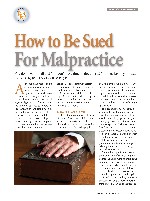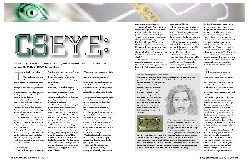Investigate and Document!
I would like to expand on a few things said by John Classe, O.D., J.D., in, How to Be Sued For Malpractice, in the October 2004 issue.
| Doctors would do well to consider any drop in acuity below 20/20 in one eye or both eyes, or any reduction in acuity from one year to the next, to be a sign of serious disease until absolutely proven otherwise. |
Dr. Classe identifies failure to determine the cause of reduced acuity as an important cause of malpractice claims. He may have underemphasized this. Far too often, relatively small reductions in acuity are ignored or not well investigated or not investigated at all. Doctors would do well to consider any drop in acuity below 20/20 in one eye or both eyes, or any reduction in acuity from one year to the next, to be a sign of serious disease until proven otherwise. This means more than a mere explanation. There should be a reason for the explanation, and it must be documented in the chart. For instance, too often doctors attribute reduced acuity in one eye to amblyopia when there is no obvious reason for amblyopia. This will leave the doctor without a defense in a malpractice claim. At minimum, ask the patient if the reduced acuity has been there for a long time, if it has changed and if he or she is aware of it. If the patient was not aware of it, or it has changed, and you cant find a definitive reason, always obtain a second opinion from another doctor.
 |
Another source of malpractice exposure, not discussed by Dr. Classe, but related to the above, is a doctors failure to fully address and explain the complaint that led the patient to obtain an eye exam. Doc-tors must address complaints by finding the cause, or be able to offer an explanation that is supportable by the exam findings or the normal anatomy or physiology of the eye. It is too easy to become distracted and forget that the previously undetected glaucoma you found is not what the patient was complaining of, and simply forget to look for the source of that problem. Always document the explanation for the chief complaint in your chart. Craig S. Steinberg, O.D., J.D.,Oak Park, Calif.
Men Can Be Victims Too
I enjoyed reading the article, CSEYE, by John Murphy, in the November 2004 issue. However, I was rather dismayed at the section featuring Dr. Denise Pensyl. She talks about her approach to her female patients whom she suspects have been abused, but makes no mention of spousal abuse of men.
One of the biggest problems with this form of abuse is the lack of acknowledgement from politicians and professionals. I am very disappointed that one of my own colleagues has chosen to sweep this very real problem under the rug. Larry Gies, O.D., Edmonton, AB, Canada
 |
Senior Editor John Murphy responds: In discussing the issue of domestic abuse, Dr. Pensyl did emphasize the often unspoken topic of abuse to men. Due to space limitations, this was not included in the article. Dr. Pensyl pointed out that as many as 5 to 10% of domestic abuse victims are male.
Vol. No: 142:2Issue:
2/15/05

